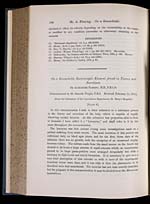Alexander Fleming (1881-1955)
On a remarkable bacteriolytic element found in tissues and secretions
306
Mr. A. Fleming. On a Remarkable
mechanical effect. its velocity depending on the extensibility of the vessels
as modified by any condition (muscular or otherwise) obtaining at the
moment.
REFERENCES.
(1) ‘Hermann’s Handbuch,’ vol. 4, p. 229 (1880).
(2) Rhode, ‘Arch. f. exp. Path.,’ vol. 68, p. 401 (1912).
(3) Roy, ‘J. Physiol.,’ vol. 3, p. 125 (1880).
(4) Luciani, ‘Human Physiology,’ vol. 1, pp. 261–263 (1911). Macmillan.
(5) Gallavardin, ‘La Tension artérielle en Clinique,’ Paris, 1920, p. 169. Masson.
(6) Morrow, ‘Pflüger’s Arch.,’ vol. 79, p. 442 (1900).
(7) Moens, ‘Die Pulskurve,’ Leiden, 1878, p. 90.
__________________
On a Remarkable Bacteriolytic Element found in Tissues and
Secretions.
By ALEXANDER FLEMING, M.B., F.R.C.S.
(Communicated by Sir Almroth Wright, F.R.S. Received February 13, 1922.)
(From the Laboratory of the Inoculation Department, St. Mary’s Hospital.)
[Plate 9.]
In this communication I wish to draw attention to a substance present
in the tissues and secretions of the body, which is capable of rapidly
dissolving certain bacteria. As this substance has properties akin to those
of ferments I have called it a “Lysozyme,” and shall refer to it by this
name throughout the communication.
The lysozyme was first noticed during some investigations made on a
patient suffering from acute coryza. The nasal secretion of this patient was
cultivated daily on blood agar plates, and for the first three days of the
infection there was no growth, with the exception of an occasional staphy-
lococcus colony. The culture made from the nasal mucus on the fourth day
showed in 24 hours a large number of small colonies which, on examination,
proved to be large gram-positive cocci arranged irregularly but with a
tendency to diplococcal and tetrad formation. It is necessary to give here a
very brief description of this microbe as with it most of the experiments
described below were done, and it was with it that the phenomena to be
described were best manifested. The microbe has not been exactly identified,
but for purposes of this communication it may be alluded to as the Micrococcus
lysodeikticus.


